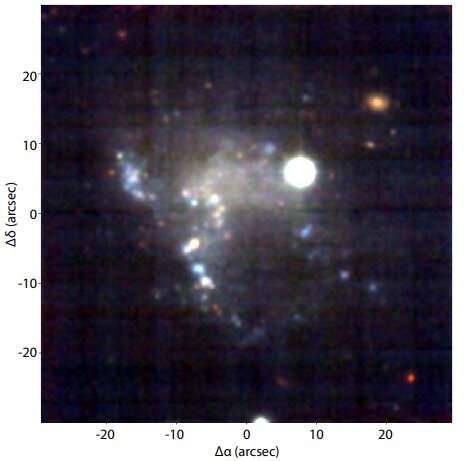Color composite image of JKB 18. Credit: James et al., 2020.
Using ESO's Very Large Telescope (VLT), astronomers have probed the chemical composition of a nearby metal-poor star-forming dwarf galaxy known as JKB 18. Results of the new observations indicate that the galaxy is chemically inhomogeneous. The study was published June 18 on the arXiv pre-print server.
Studies of spatial distribution of metals in the gas throughout galaxies could be essential to improve our understanding of galaxy evolution in general. However, obtaining detailed spectroscopic information required to analyze spatial distribution of metals and chemical homogeneity of the first galaxies is limited with currently available instruments. Therefore, astronomers are trying to investigate nearby low-metallicity star-forming galaxies as they can serve as analogs of complex systems formed in the early universe.
Located at a distance of just 59 million light years away, JKB 18 is one of such galaxies. It is a low-metallicity dwarf galaxy with a stellar mass of around 100 million solar masses and average star-formation rate of approximately 0.002 solar masses per year. The system exhibits an interesting morphology, with numerous sites of ongoing star-formation scattered randomly among a diffuse body.
A team of astronomers led by Bethan L. James of the Space Telescope Science Institute in Baltimore, Maryland, decided to take a closer look at the chemical composition of JKB 18. They employed VLT's Multi Unit Spectroscopic Explorer (MUSE) to conduct a detailed spatially resolved spectroscopic study of this galaxy with the aim of investigating the distribution of metals throughout the system's ionized gas.
"The goal of this study was to explore the chemical homogeneity of a low-metallicity, star-forming dwarf galaxy using the high spatial resolution, wide area coverage, IFU [integral field unit] data afforded by VLT/MUSE," the researchers wrote in the paper.
The study found that JKB 18 has a rather complex ionization structure, with regions of highest ionization lying offset from the galaxy's main star-forming regions. The gas in JKB 18 appears to be dominated by photoionization, according to the astronomers.
MUSE observations allowed the team to calculate chemical abundances for individual HII star-forming regions (containing clouds of ionized atomic hydrogen) and to derive oxygen abundance maps of JKB 18. Based on these data, the researchers assume that the studied galaxy is chemically inhomogeneous.
"With large-scale dispersions in O/H, N/H and N/O of ∼0.5–0.6 dex and regions harboring chemical abundances outside this 1σ distribution, we deem JKB 18 to be chemically inhomogeneous," the paper reads.
Trying to find the most plausible cause of the observed inhomogeneity, the astronomers suggest that it could be attributed to the removal of gas via supernovae and specific timing observations. They rule out such scenarios as the accretion of metal-poor gas, short mixing timescales, or self-enrichment from Wolf-Rayet stars. More high spatial-resolution studies of JKB 18 are required to verify these assumptions.
More information: Exploring Chemical Homogeneity in Dwarf Galaxies: A VLT-MUSE study of JKB 18, arXiv:2006.10768 [astro-ph.GA] arxiv.org/abs/2006.10768
© 2020 Science X Network
























